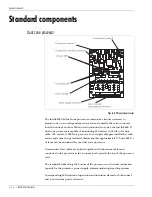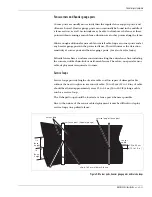
Upgrade existing structures
4 - 6 • • • Intelli-FLEX II product guide
Climb-over deterrent hardware
Figure 4-3 Barbed wired outrigger with bracing wires installed
Many fences and walls include barbed wire outriggers as a physical deterrent to
climb-over intrusion attempts. These outrigger arrays must be secured to prevent
casual movement due to environmental conditions. Each strand in the outrigger
array should be taut and tightly secured at each support.
Install bracing wires between the outrigger supports to prevent the barbed wires
from spreading apart.
All top-of-fence material and deterrent hardware should meet the following
minimum specifications:
•
Any extension arms or outriggers attached to post tops should have a tight
press-fit or should be spot welded. Loose or rattling equipment should be
fastened down or removed.
•
The use of barbed tape is NOT recommended. It is difficult to fasten tape to
prevent noise generation. If barbed tape must be used, every effort should be
made to minimize noise generated from the movement of the tape. This
requires tying the barbed tape at specific points where motion can cause the
tape to touch the fence.
Other structures
The Intelli-FLEX II system has been used on other types of fence structures. It has
been deployed on wooden fences, on indoor walls to detect break through, in
conduit along the top of concrete or brick walls to detect climb-over, along wire
conduits to protect sensitive data cables, even in the handrails of a yacht to detect
intrusion onto the ship while it is moored.
For Intelli-FLEX II installation information on wrought iron, or any other type of
fences that might be included in the security perimeter of your site, please contact
Senstar.















































